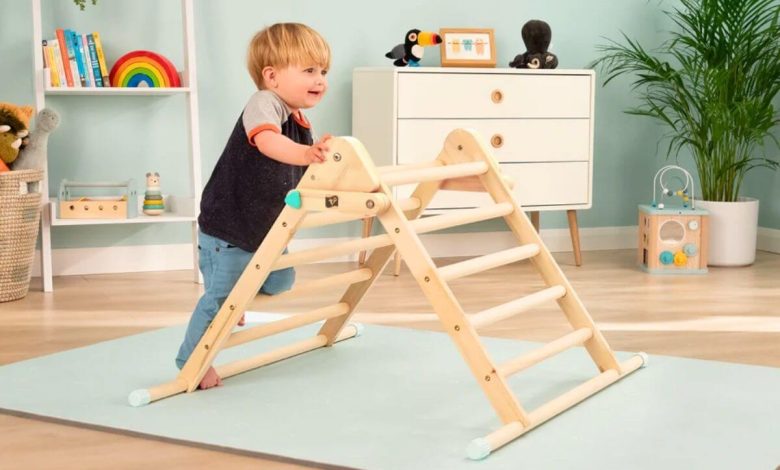Movement and Development: The Science Behind Montessori Climbing Equipment

In the world of early childhood development, few approaches have garnered as much respect and scientific validation as the Montessori method. At the heart of this educational philosophy lies a profound understanding of movement’s role in cognitive development. Today, we’ll explore why Montessori climbing equipment, increasingly popular in Australia and worldwide, isn’t just about physical play – it’s about building better brains.
The Neural Dance: How Movement Shapes Brain Development
When a child climbs, reaches, and balances, they’re not just exercising their muscles; they’re literally building their brains. Research in developmental neuroscience has shown that physical movement, particularly the kind encouraged by Montessori climbing equipment, directly stimulates the cerebellum – a region of the brain once thought to be solely responsible for motor control but now known to play a crucial role in cognitive development.
During early childhood, the brain forms millions of neural connections every day. These connections are strengthened through repeated physical activities, especially those requiring balance, coordination, and spatial awareness. This is where Montessori climbing equipment becomes a powerful developmental tool. Each climbing experience creates and reinforces neural pathways that will serve children not just in their physical development, but in their cognitive growth as well.
Learning Towers: More Than Just a Step Up
Among the most versatile pieces in the Montessori toys Australia market, learning towers exemplify how thoughtfully designed equipment can support multiple developmental areas simultaneously. These structures, which safely bring children to counter height, do more than simply allow young ones to participate in everyday activities.
When children use learning towers, they engage in what developmental psychologists call “purposeful movement.” This type of movement, directed toward a specific goal (like helping to prepare food or wash dishes), combines physical development with practical life skills. The act of climbing into the tower, maintaining balance while standing, and engaging in activities at counter height helps develop:
- Proprioception (awareness of body position)
- Core strength and stability
- Hand-eye coordination
- Executive function skills
- Confidence and independence
The Montessori Climbing Frame: A Framework for Development
The Montessori climbing frame represents perhaps the most comprehensive approach to movement-based learning. These structures, with their clean lines and natural materials, offer what development experts call a “prepared environment” – a space specifically designed to support the child’s natural inclination to move and explore.
Recent studies have shown that regular use of climbing frames can significantly improve children’s:
- Gross Motor Skills: The varied climbing challenges help develop strength, balance, and coordination.
- Risk Assessment Abilities: Children learn to evaluate heights, distances, and their own capabilities.
- Spatial Awareness: Through climbing and navigating the frame, children develop a better understanding of three-dimensional space.
- Problem-Solving Skills: Each climbing session presents new challenges and pathways to explore.
The Triangle of Success: Understanding the Climbing Triangle
The Montessori climbing triangle, with its simple yet versatile design, offers a fascinating example of how basic geometric shapes can support complex developmental processes. This piece of equipment, beloved by families and educators alike, provides a scalable challenge that grows with the child.
Research into motor development suggests that the climbing triangle’s inclined surface is particularly beneficial for developing:
- Cross-lateral movement patterns
- Core strength
- Balance and coordination
- Confidence in physical abilities
The Research Behind the Results
Scientific studies have consistently shown that children who engage regularly with climbing equipment demonstrate improved:
- Executive function skills
- Problem-solving abilities
- Spatial reasoning
- Physical confidence
- Social skills (when climbing with peers)
A 2019 study published in the Journal of Motor Learning and Development found that children who had regular access to climbing equipment showed significantly better development in both gross motor skills and cognitive problem-solving compared to those who didn’t.
Implementing Movement in Your Space
For families considering incorporating Montessori climbing equipment into their homes, it’s important to understand that these aren’t just play structures – they’re developmental tools. When choosing equipment, consider:
- Age-Appropriate Challenges: Start with simpler structures for younger children and progress to more complex ones.
- Space Requirements: Ensure adequate fall zones around equipment.
- Quality and Safety: Look for well-constructed pieces from reputable Montessori toys Australia suppliers.
- Versatility: Choose equipment that can be reconfigured or adjusted as your child grows.
Conclusion: Movement as a Foundation for Learning
The science is clear: movement matters. Montessori climbing equipment provides not just opportunities for physical activity, but a foundation for cognitive development, emotional growth, and learning readiness. Whether it’s a learning tower in the kitchen, a climbing frame in the playroom, or a climbing triangle in the living room, each piece of equipment contributes to a child’s developmental journey in unique and important ways.
As we continue to understand more about the connection between movement and brain development, the wisdom of Maria Montessori’s approach becomes increasingly apparent. By providing children with opportunities for meaningful movement through carefully designed equipment, we’re not just supporting their physical development – we’re helping build stronger, more capable brains for the future.
Remember: Always supervise children during climbing activities and ensure all equipment meets current safety standards.



